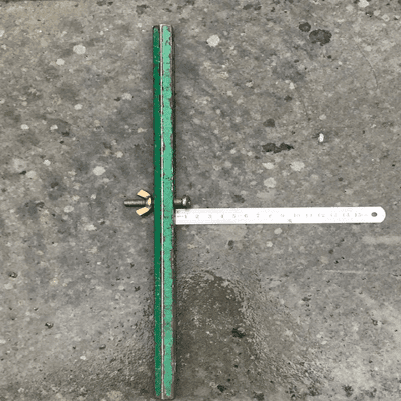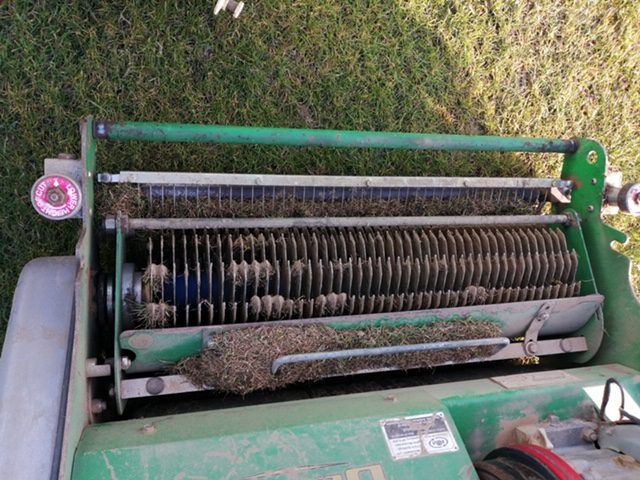How to prepare a cricket ground for the season is a comprehensive guide by Brian Sandalls, Award-winning Groundsperson at Sussex Cricket and founder of TurfCareBlog.
It covers the transition from a cold and wet Winter, hopefully into a warmer pre-season period, with guidance on preparing squares and outfield.

Preparing the Square
Cleaning up of the square
If you have access to a mower/verticutter or brush cassette with a grass box, then a few light passes over the square would be the ideal. This will clean up the square of debris, such as rabbit droppings, small twigs and dead leaves from the grass plant, that have been shed over the winter and lay amongst the canopy of grass.
Worms
Take a look at this blog – https://turfcareblog.com/how-to-control-worms-on-sports-pitches/
Pre-season rolling

Most clubs in our community suggest weather allowing, they start pre-season rolling in or around the late Feb/early March.
This is usually started off with a cylinder mower (20-24” mower width) and as the soil dries out, weights can be increased to (30-36” width) until it is possible to roll the square with the heaviest roller (ballasted), without leaving any indentations/crease marks in the soil.
Some groundsmen recommend not starting pre-season rolling until temperatures are around 10°C, l tend to just start it when l feel the plant is growing and the soil is at a drying stage, which is usually around the start of March.
Location could be a massive factor in this, as l am based in the sunny south.
How many directions, every square is unique, based on soil type, loam used, region so l don’t think it’s right to prescribe a generic guide to this.
Take a look at this blog on pre-season rolling – https://turfcareblog.com/essential-guide-to-rolling-iain-james/
Notes on pre-season rolling
Pre-season rolling in April when the soil is drying fast, CAN be much less effective so whatever the start date of the season, l would still recommend a March-onwards programme of pre-season rolling.
Please don’t get confused with there being enough moisture in the soil and the soil being wet. We cannot compact water, only manipulate the soil into the air spaces in the soil and this can only be done when the soil is moist, not wet.
If the soil when rolling, caps, seals, smears, ridges or buries grass it is too wet. If so, just go and put the kettle on and return at a more suitable time.
Moss
Take a look at this recent blog – https://turfcareblog.com/moss-control-on-turf-5-ways-to-beat-it/
Squaring up the square
Ensuring the square is squared up is pretty vital to ensuring all wickets are equal in length (66 ft adult) and all the popping creases line up and look right.
Please see this blog on squaring up the square: https://turfcareblog.com/how-to-square-up-a-cricket-square-step-by-step/

Nutrition – Feeding
I ideally like to get a feed on pre-season rolling as this can be quite a stressful time for the grass, and up till around mid-March, a low nitrogen-based feed in the range of 4-8% is suitable.
There is also an opportunity often between the end of pre-season rolling or a band of wet weather, to get a feed on to strengthen the plant up after the stresses of pre-season rolling. Fertilisers by this (mid/late March) time can be higher in nitrogen i.e., 14% nitrogen as an example.
Just avoid feeding the wickets you are planning on cutting out first.
If overseeding large areas, a feed containing phosphorus will help with root and shoot development.
Avoid applications of fe (iron), as an application of iron to a young grass plant when at the one leaf stage could damage the leaf. Always an option to use a non-fe product this time of year, if you have any newly sown grass.
Any doubts, read the bag and speak to those who supply your fertiliser, for advice on the correct product in your circumstances.
Why do we need to feed?
Have a read of the TurfCare Blog article called 5 Reasons to Feed Your Turf This Winter.
Height of cut (HOC)

Over the coming weeks, we need to start/continue to reduce the HOC (height of cut), of the square to around 12-15mm.
Personally, l like to go down to 12mm at the start of the season and raise up as the grass get stressed during hot periods. Aim not to stress the plant too much by removing no more than a third of the leaf in any one cut.
12mm in height of cut may not be possible for your square if there are any level issues and so this HOC will not be achieved until we are into April, weather permitting.
Over Seeding
Always a tricky one around times of pre-season rolling, l have found that pre-season rolling is carried out over a number of weeks or weekends for volunteer Groundsmen.
There are also breaks in the weather, which will create a natural opportunity to get some overseeding down. I look to get any seeding down towards the final stages of pre-season rolling.
When to overseed
This can be dependent on where you are based in the country, but once you’re cutting grass and it’s growing with temperatures over 10°C or even a bit lower the seed will germinate.
Heavy frost can also damage young grass plants, horticulture fleece or germination sheets can be of help.
When to overseed, if the weather is warm and settled get the seed in (around March)?
If you’re worried about pre-season rolling, you can either delay seeding till later stages on rolling (possibly roll seed into the surface), or just overseed the ends for now and go around them during pre-season rolling.
Key to seeding is seed/soil contact so create shallow holes; a sarel roller, grooves, anything to get the seed 10-15mm into the surface.
This is a useful blog on grass seed facts – https://turfcareblog.com/13-essentials-things-to-know-about-grass-seed-prior-to-renovations/
Pitch preparation
Typical pitch preparation for early season wicket ranges from 14-21s days, every square dries differently and the weather and the clay content of the square, all mean there is no set preparation period.
As a guide, we go with three weeks, but at most clubs l know it would be around two weeks. The weather really is the ultimate deciding factor and then the level of cricket to be played, your experiences will trump my thoughts.
Take a look at this blog – https://turfcareblog.com/how-to-prepare-a-cricket-pitch-net-in-5-steps/
Work out a pitch position planner
This can be done once you have all your fixtures in place, the ideal is to alternate pitch positions in odd numbers, so pitch 2 then, 4, 6 and once you’re at the end of the square say it’s 8, then fill in the gaps, so 3, 5, 7.
In reality, this doesn’t always work out but it’s a good starting point to the planning process. This is a challenge for clubs where the first team insist on using only the middle pitches.
My own pitch plan starts with the priority fixtures, ensuring these fixtures are played on middle tracks and then l work the rest around these dates.
Verticutting

February/March can be quite cold months, but with the weather, you never know and if the grass is growing well and regrowing then into March you could start looking at verticutting the square.
I would bear in mind unless it’s unseasonably warm, it probably won’t need to be done too many times, in comparison to a more regular spring verticutting regime from April onwards.
No Verticutter? Maybe you have a Sisis Lawnman? This can be used as a way of cutting any vertical growth and encouraging a more upright plant.
Related blog on verticutting – https://turfcareblog.com/how-to-control-and-prevent-annual-meadow-grass/
Preparation of the Outfields
Outfields are not often within the control of clubs, but where they are, a reduction in the height over the next few weeks, over a few cuts to whatever your requirements in terms of HOC.
We aim for 12mm, but if you have thatch or poor surface levels you won’t be able to go so low and many clubs are at the mercy of local councils.
Our first games will be for Sussex seconds, so the standard of cricket is something to bear in mind, so 15-20 mm is pretty common, if not higher.
If nothing else, get around the outfield or even better get someone else to and clear up any twigs/small branches that have fallen. These have a way of getting in the outfield cylinder mower and then gouging outlines of soil, if you’re unlucky.
Some groundsmen like to roll the outfields, I am not a fan (if too heavy) of this and feel the weight of the triple mower will be sufficient to settle what little frost heave that may have occurred. If you are to roll, consider getting a contractor to use a spring harrow instead, if levels on the football pitch are your concern.
This is a very helpful blog, on how to turn a football pitch, into a cricket outfield – https://turfcareblog.com/how-to-turn-your-football-pitch-into-a-cricket-outfield-basic-guide/
Marking Out of the Pitch
Take a look at this step-by-step guide to marking out or and watch this video from the ECB.
Artificial net/match pitch surface preparation
Take a look at this handy guide on our website – https://turfcareblog.com/non-turf-maintenance-guide-2020/
Other jobs
Equipment – Such as screens and boundary ropes in place and scoreboards to be painted as required. Netting for net areas and non-turf areas. Dome tops and any sheets out and any holes identified.
Materials – If you have some small areas, like ends that are a bit thin, use up some seed if there’s any in the shed, or if not, get some new stock in. Loam for footholes and pitch repairs and there’s fertiliser and white liner possibly to source.
Machinery – If not already done so, get your machines serviced, before you really need them and get in fuels and oils for the machines.

Contact Brian & TurfCareBlog
Thanks to Brian for his insight into preparing your cricket ground for the new season. There’s lots of detail here for all types of cricket ground, knowledge of volunteer and situations.
If you want to contact Brian about anything you’ve read here, you can email him at @[email protected].
TurfCareBlog.com has articles on anything you could possibly want to learn on the maintenance of cricket grounds.
You can Like the @turfcareblog Facebook page for updates or Follow @turfcareblog on Twitter.
There’s also a thriving community through the Groundsperson UK Facebook Group if you’d like to join that.
*This is a sponsored article for TurfCareBlog – if the mood takes you, click to read Cricket Yorkshire’s policy on sponsored content*
- Nidderdale League: North Stainley and Studley Royal swap fortunes - September 8, 2025
- Record-breaking Greaves leads Wickersley Vixens to victory - September 1, 2025
- Whiston Parish Church Belles prove the perfect advert - August 5, 2025